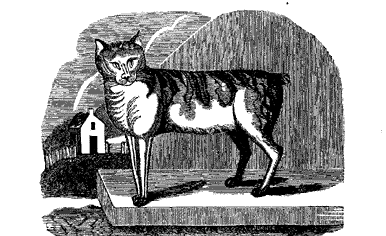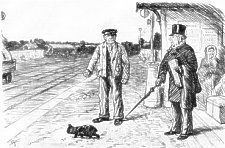

Possibly the best known export from the Island! - John Welch's rather caustic comment [re isolated Dalby on the West coast] is:
Just beyond Glenmoij is Dalby, which on account of its total seclusion from all society may be denominated " the fag end of a God forgotten-world" The uncontaminated Manx breed of men and cats may be found here in all purity. The most singular feature in the natural history of this country is, that the genuine, aboriginal, orthodox cats have no tails; there is also a kind of poultry without this appendage, and they are both called, by way of distinction, " runtties." But as they intermarry with the more favoured English breeds, they have a quarter of a tail, half a tail, three quarters of a tail, and full tail; according to some scale of deserts with which I am unacquainted.
The classic account is by Joseph Train: [1844]
According, to my friend, Mr. Forbes, the only quadruped peculiar to the Island, of which it can boast, is the tail-less cat, called in Manks, "Stubbin," and in English, "a Rumpy." This is, he thinks, an accidental variety of the common species felis catus, frequently showing, no traces of caudal vertebrae, and others merely a rudimental substitute for it.1 There is a tradition still current in the Is land, that the first rumpy cat seen there was cast on shore from a foreign vessel that was wrecked on the rocks at Spanish Head, but at what period no one pretends to say. A modern author speaks with more certainty by affirming that the rumpy is the genuine aboriginal cat of the Island.2 As a mouser, the rumpy is preferred to all others of its kind. Formerly when cats were scarce in Europe, the rumpy would have brought a high price.3 In Wales the value of a cat was fixed by law, and the same regulation extended to the Isle of Man, when-under the rule of the Cambrian Princes.4 The Manks rumpy resembles some what in appearance the cats said by Sir Stamford Raffles to be peculiar to the Malayan Archipelago.5 Of late years, many rumpies have been carried out of the Island as curiosities by visitors. I have had one in my possession for upwards of four years-a circumstance which has afforded me an opportunity of observing the habits of the animal.'My observations on the structure and habits of the specimen in my possession, leave little doubt on my mind of its being a mule, or crosses between the female cat and the buck rabbit. In August, 1837, I procured a female rumpy kitten, direct from the Island. Both in its appearance and habits it differs much from the common house cat: the head is smaller in proportion, and the body is short ; a fud or brush like that of a rabbit, about an inch in length, extending from the lower vertebra, is the only indication it has of a tail. The hind legs are considerably longer than those of the common cat, and, in comparison with the fore legs, bear a marked similarity in proportion to those of the rabbit. Like this animal too, when about to fight, it springs from the ground and strikes with its fore and hind feet at the same time. The common cat strikes only with its fore paws, standing on its hind legs. The rumpy discharges its urine in a standing posture, like'a rabbit, and can be carried by the ears apparently without pain. Like every species of the felince, it is carniverous and fond of fish, and is an implacable enemy to rats and mice. My little oddity was six months old before it saw a mouse, but when a dead one was exhibited, it instantly displayed all the characteristics of a practised mouser. It has never had any offspring, although the common cat propagates its species when about twelve months' old. Indeed, on this subject, although I have made many inquiries, I have not been able to establish a single instance in which a female rumpy was known to produce young. My opinion, as to the origin of the rumpy, has been strengthened by a coincident circumstance connected with this district. A few years ago, John Cunningham, Esq., of Hensol, in the stewartry of Kirkcudbright, stocked a piece of waste land on his estate with rabbits, which multiplied rapidly. In the immediate neighourhood of this warren rumpy cats are now plentiful, although previously altogether unknown in the locality. Not a doubt seems to exist as to the nature of their origin. I am afraid the known facilities which exist in the Isle of Man, for giving effect to this opinion as to the origin of the rumpy, may go far to dissipate the cherished belief of the Islanders, in its being a distinct genus. At the same time I am far from wishing my statements to be understood as settling the question. My opportunities of observation have induced this general opinion of their origin, but, as it is possible many local objections may be taken to its reception, I would willingly avail myself of any authenticated communication on this head, before the final publication of my work. I have no wish, apart from the discovery of truth, to deprive the Island of this, or any of its peculiarities.
1 Natural History of the Isle of Man, by Edward Forbes; Quiggin's Isle of Man Guide, p. 40.2 A Six Days' Tour in the Isle of Man,in 1836, p. 151.
3 Sir William Jardine',s Naturalist's Library, "Mammalia," vol. ii, p. 243.
4 The price of a kitten, before it could see, was a penny; after it could see, and before it caught a mouse, two-pence ; and after it had caught a mouse, four-pence ; which was a large sum in the tenth century. It was required, besides being a good mouser, that it should be perfect in its senses of hearing and seeing, and likewise should have good claws. If it failed in any of these qualities, the seller was to forfeit to the buyer the third part of its value. If any one stole or killed the cat that guarded the prince's granary, he was to forfeit a milk ewe, its fleece, and lamb, or as lunch wheat as, when poured on the cat suspended by the tail, the head touching the floor, would form a heap high enough to cover the tip of the tail-
Laws of Hytvell Dha, folio edition, London, 1730.
Train's theory as to its origins can now of course be laughed at - the famous Manx zoologist Edward Forbes was more accurate - the Manx cat is not a separate species but carries a gene that results in the absence (partial or total) of the tail.
The only remarkable quadruped peculiar to the Island, and of which, it can boast, is the tail-less cat, an accidental variety, of the common species, Felis Catus, frequently showing no traces of caudal vertebrae, and in others a merely rudimental substitute for it.
The exact genetic makeup seems undecided - the gene for taillessness would appear to be progressive but no true homozygous Manx Cat exists. There thus is no guarantee that they will breed true (and in fact some kittens may be severly deformed) - hence the truth of John Welch's comments.
The first appearance of the Manx Cat in print would appear to be in 1810 referring to some tailless cats owned by Turner (the famous English painter) which were said to be from the Isle of Man. A further reference in 1834 Magazine of Natural History says that the author saw several in the huts of the peasantry among the mountains between Ramsey and Peel and that he was told they had come from a wreck of a vessel from Prussia or some Baltic port many years ago. [FPC this sounds rather like the Russian ship c.1785 wrecked on Kitterland that allowed rats to escape to the calf and wipe out the Calf 'puffins'.]
The common name 'Stubbin' would indicate that the cat was a relatively recent introduction to the Island as before 1750 the majority spoke Manx yet 'stubbin' is obviously derived from the English. "Stub'bin s.m. a cat without a tail" appears in Cregeen's Manx Dictionary of 1835 - as does runtey for round,circular.
As stated earlier the Manx Cat is of recent introduction and no authentic Manx myth is attached to it (if so it would have certainly appeared in Waldron's 1726 account which is the basis for much of our knowledge of Manx folklore) - however the story by Sophia Morrison of How the Manx Cat lost her Tail is worth reading.
|
|
It is supposed to make an attractive and lovable pet. |
The loss of the tail is often seen in various jokes - that below appeared in Punch 29 Oct 1870

A Lusus Machiner - Æ
Chatty Passenger. "Porter ! That's one of those curious tailless Manx cats is it not "
Crusty Porter (shortly). "No, 'taint. Morn'g 'xpress!"
Passenger (puzzled). "E-h—I don't understand—"
Porter. "Don't yer! Well, you come and put your toe on there 'ere down metals about 9.14 a.m. tomorrow, and —"
Passenger (enlightened). "Ah!—I see—jus' so—" retires under cover of newspaper.
[lusus machiner =(approx) an artificial amusement.]
T. Talbot The History of the Manx Cat: its origin, great antiquity, and the cause of the absence of its caudal appendage etc. Douglas: Clucas & Mollard Herald Office c1882
D.W. Kerruish, The Manx Cat Douglas: [Island Development Co] 1964 (ISBN 0-9502312-0-7) (a revised edition was published 1965)
R. Kelly Tales of the Tailless Douglas: The Manx Experience [1996] (ISBN 1-873120-22-2) (well illustrated, including many reproductions of Louis Wain's Cat-postcards - highly recommended and still in print in 1999)
The Manx Cat:Two early published references J. Manx Museum vii #83 p35 1967
|
|
||
|
Any comments, errors or omissions
gratefully received The
Editor |
||